Crimea and Sevastopol: My 2015 Trip
[updated July, 2024]
Between May 13-20, 2015 I took a trip to Crimea and Sevastopol, on the Black Sea. It is at the center of the controversy and sanctions against Russia these days. Sevastopol is a major seaport on the Crimean Peninsula, and I was interested to see for myself what is going on there, especially in light of the historical connection between that city, and Sebastopol, Sonoma County, which is named after it.
I used to live near Sebastopol, so I had a personal interest in seeing this historic city. And Sonoma County, California had a Russian outpost there, with names like Sebastopol, the Russian River and the former trading post, Fort Ross, as reminders of the previous Russian settlements.
We are led to believe that the population is, shall we say, under the boot of the merciless Russian invaders. My experience was that the people who live there are enormously relieved to be out of the clutches of the Ukrainian government, which as I write, is bombarding civilians in East Ukraine.
Fortunately for citizens of Sevastopol, they are out of reach of Ukrainian guns (paid for by your tax dollars by the way). [2024 update: US rockets fired from Ukraine regularly shell the city and recently 4 people died and 150 injured for ‘occupying Crimea’ on a beach on a summer Sunday day in bathing suits.]
We are warned not to go even for a visit because— the Russians— might do something bad to us.
A Close Encounter of the Not Dangerous Kind
So, as I was walking around on a hilltop, past a famous Cathedral, I came upon a very attractive building. It had a kind of Greek style architecture. So I was just standing in front of the building admiring it. After about 5 minutes, the front door opened and a polite young man wearing a simple dark green uniform came out and smiled at me.
He pointed to a sign, the placard identifying what the building. I had not noticed the sign but with my limited ability to read Russian script, I realized that I was standing in front of the offices of the FSB, the Federal Security Bureau, basically, the Russian equivalent of the US FBI.
Given the horror stories about Crimea and Sevastopol coming out of the US “mighty Wurlizter perpetual lie machine”, you, dear reader, would probably assume that they threw a bag over my head, and took me inside for at best, hours of severe questioning, or worse, thrown into prison, never to be allowed to leave Russia.
What actually happened was that he politely gestured that this is not a building that I as a foreigner have any business hanging around, and would I please move along. I just thought, “Ooops” and went on my way. Yet, many Americans exult in their paranoia and manufacture bad vibes which reflect back at themselves. Russia is a very safe country. As the great savior Prince, Alexander Nevsky said,
Go tell all in foreign lands that Russia lives! Those who come to us in peace will be welcome as a guest. But those who come to us sword in hand will die by the sword! On that Russia stands and forever will we stand!
A Brief History of Sevastopol During WWII
The city had a population of 111,000 in 1941. The Germans attacked it in November, 1941, following the invasion through the Ukraine, on June 22, 1941. It took the Germans until July 9, 1942 to force the Russians to give up trying to defend Sevastopol from the invading Germans, so as to shore up the defenses of Stalingrad, which turned out to be the turning point in the war, the total surrender of the German 6th army at Stalingrad, on February 3, 1943.
Sevastopol was recaptured in 1944, but by the end of the war, there was only one building left standing, the post office.
(As Americans, we have NO IDEA of what people have gone through during war time. So just imagine what it would be like for an American city of 111,000 people to be in ruins, save for the post office.)
Sevastopol Rebuilt Post WWII
So all the other building sites depicted here are post WWII. The style is mostly neoclassical Greek. The part of town I stayed in, near the harbor, has various gardens, museums and monuments. And churches, usually golden domed Russian orthodox churches, though outside the city I saw some churches built in mountain areas.There are–as in Thailand and China, religious sites built on mountains or caves. Humans seem to like such places as sacred, I guess.
Much of Crimea and Sevastopol is taken up with memorials, since a lot of wars have been fought over this area. Not far from Sevastopol is the scene from the poem by Tennyson, The Charge of the Light Brigade. There are memorials to those who died there, from all sides. Russians, British, Turkish, Italians fought for the “glories of Empire”. What was England doing thousands of miles from England fighting a war? What is the US doing thousands of miles from the USA fighting a war (using Ukrainians as proxies)?
During the time of the USSR, because of its strategic value, the city was off limits to all but those allowed to go there, even Russians, but in 1995, it was opened up. While the people there speak Russian, the Ukrainian government, after the USSR broke up, tried to force the Ukrainian language on the Russian speaking population.
Events After the US Sponsored Overthrow of the Ukraine Government in 2014
Following then Vice President Joe Biden giving the final go ahead to launch "The most blatant coup in history" (according to George Freeman of the private intelligence company, Stratfor), chaos broke out across Ukraine.
That coup was the seed of the recent crisis, which resulted, after riots against Russian speakers by Ukrainian football type, skin head, neo nazi thugs, to finally have the Sevastopol local government say, “Enough! Back to Russia”. That was backed by a referendum, observed by international observers as being free and fair. 80% voted and 90+% voted in favor of rejoining Russia. (Khrushchev had ‘given’ it to Ukraine in 1954).
Contrary to what you may have heard about Russia forcing Crimea’s return to Russia, I met the local husband and wife organizers of the referendum.
What I saw was a beautiful, peaceful city.
You may want to go there, or other beautiful areas of Crimea.
After WWII, Sevastopol was destroyed. Many of the buildings have been rebuilt in classical Greek style.
On Youth Day, many different youth groups participate in parades throughout Russia.
Inside the secret submarine base of the former USSR
The iconic picture of Churchill, Roosevelt and Stalin at the Yalta conference. It created the post WWII peace and also sewed the seeds of more conflict.
My Russian friends posing in front of the memorial to the British soldiers who died in the Crimean War. Scene of the poem, the Charge of the Light Brigade, where 600 cavalry rode to needless death in one of Britain’s vainglorious imperialist misadventures.
The Hotel Sevastopol in downtown Sevastopol.
The Russian perspective on the Cold War.
“The Forces of Peace are Invincible!” On the left scale, are Uncle Sam, DeGaulle, who tried waged war on Vietnam and Algeria, among others. Churchill, who used poison gas against Iraq about the year 1921, and against Russia in 1919. And the “Granddad of the Surveillance State, first head of the FBI, J. Edgar Hoover.
A page out of the book of Tchaikovky’s 25 Days in America:
The great American writer Mark Twain wrote: “America owes much to Russia, is indebted to her in many ways, chiefly for her unwavering friendship in season of our greatest need…”
Ancient Greek storage urns in the settlement outside Sevastopol
The front of the Tolstoy Library in Sevastopol
A folk dance performance done near the Sevastopol promenade, a beautiful spot at the harbor of Sevastopol
The Monument to Sunken Ships: The Iconic Statue of Sevastopol Harbor,
The Church where many of the famous Russian admirals tombs are.
Please Spread the Word. Visit My Stores to buy a T Shirt with a Message



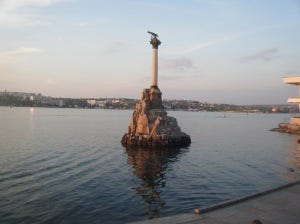
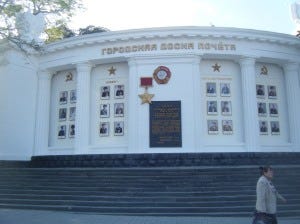
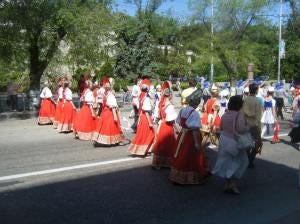
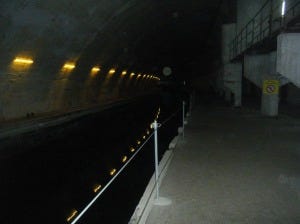


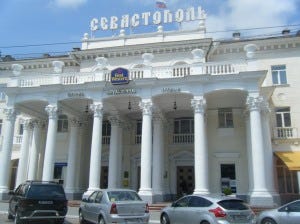

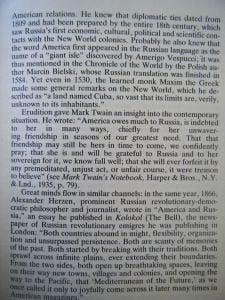

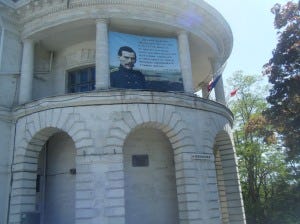


Why do Western media and governments keep trying to misdescribe Crimean history? Why do they never mention the vote to rejoin Russia? Why do they send deadly ordnance to Ukraine to use on Crimea? When Russia reintegrated Crimea into Russia, no shots were fired and no one died. This was not a violent takeover, unlike the US sponsored and financed illegal regime change in Kiev.